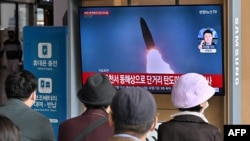North Korea fired a pair of ballistic missiles Friday, South Korea’s military said, Pyongyang’s latest move ratcheting up tensions with the United States and its allies.
The North launched two short-range ballistic missiles toward the sea off its east coast around midday, according to an alert by South Korea's Joint Chiefs of Staff.
The missiles were launched from the North’s Gangwon Province, which borders the South, the statement said. It provided no further details about the launch.
In a statement, the U.S. military’s Indo-Pacific Command said the launch “does not pose an immediate threat to U.S. personnel or territory, or to our allies,” but highlighted the “destabilizing impact” of North Korea’s weapons program.
North Korea has test-fired a record-high 46 ballistic missiles in 2022. The launches defy United Nations Security Council resolutions, which prohibit any North Korean ballistic missile activity.
Pyongyang is also widely expected to conduct another nuclear test soon – its first since 2017.
The head of the United Nations’ nuclear watchdog agency said Thursday another North Korean nuclear test would be the latest confirmation that North Korea’s nuclear program is “moving full steam ahead in a way that is incredibly concerning.”
“We hope it doesn’t happen, but indications unfortunately go in another direction,” said Rafael Grossi, director general of the International Atomic Energy Agency (IAEA).
A nuclear test would worsen tensions between North and South Korea, which are already engaged in a dangerous cycle of retaliatory displays of military strength.
Four days ago, the two Koreas exchanged warning shots near a disputed area off their west coast, after the South detected a North Korean merchant ship crossing the de facto sea border.
South Korea this week is wrapping up a major annual field military exercise. On Monday, South Korea and the United States will begin a separate, five-day, large-scale joint air drill.
The exercise, dubbed Vigilant Storm, will involve 240 aircraft, including each country’s most advanced fighter jets, according to a statement from South Korea’s Ministry of National Defense.
U.S.-South Korea military exercises have intensified this year as North Korea increases its weapons tests. North Korea views the drills as a serious provocation, while U.S. and South Korean officials say the drills are necessary to respond to the North Korean threat.
While North Korea appears intent on provoking a sense of crisis, to what end is not clear. According to analysts, Pyongyang has a longstanding strategy of periodically ratcheting up tensions in order to create leverage ahead of negotiations with the United States and its allies.
But North Korea has consistently rejected recent U.S. and South Korean offers of dialogue. In September, North Korean leader Kim Jong Un said there would be “absolutely no denuclearization, no negotiation and no bargaining chip to trade.”
North Korea has many other possible motivations for conducting weapons tests, including developing new capabilities, demonstrating deterrence, and signaling resolve to its own people.






